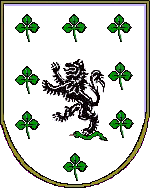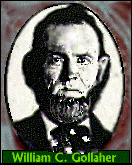![]() RETURN
TO THE GOLLAHER PAGE
RETURN
TO THE GOLLAHER PAGE
![]() VISIT
THE GOLLAHER FAMILY WEBSITE
VISIT
THE GOLLAHER FAMILY WEBSITE
![]() VISIT
THE FAMILY PHOTO PAGE
VISIT
THE FAMILY PHOTO PAGE
Michael Monroe Gollaher and Linda Ames are the two people who have sweated over and provided the information reflected on these Gollaher pages. I want to thank each one of them for this wonderful contribution. Be sure to visit Michael's "Gollaher" pages and Linda's genealogy site (click on their names to go there). If I've neglected mentioning someone else, please let me know and forgive my oversight! If you have anything to contribute, please drop me a note!
Although we don't know the birthplace of our earliest known Gollaher ancestor (Caleb), we do know that the surname is an Anglicization of the Irish name, "ÓGallchobhair." Here's a brief history of Members of the Clann ÓGallchobhair who spell their surname "GOLLAHER"
The Reverend Wolfe says of the surname: O'GALLC~OB~AIR - O Galleghure - O'Gallagher &c.
Description: Gallc~ob~ar
' - "foreign help"
"The name of a
numerous and once powerful family in Tirconnell, who derive their descent
from Maolchobha, King of Ireland in the 7th century. As marshals
of O'Donnell's forces, the O'Gallaghers took a prominent part in all the
military movements of Cinel Conail during the 14th and subsequent centuries.
Many of them were distinguished as Bishops of Raphoe and Derry. The
name was sometimes shortened to O'Gallc~u'."
OGallagher The name of the sept, Ó Gallchobhair in early Irish (gaedhelic), signifies descendant of Gallchobhar (or Gallagher), who was himself descendant from the king of Ireland who reigned from 642-654. The ÓGallaghers claim to be the senior and most loyal family of the CinealConnail. Their territory extended over a wide area in the modern baronies of Raphoe and Tirhugh (Hugh's Land) of the County Donegal, and their chiefs were notable as marshals of the ÓDonnell's military forces, particulary the cavalry, from the fourteenth to the sixteenth centuries. The principle branch of the sept were seated at Ballybeit and Ballynaglack.
Gallagher, usually with its prefix "O" in modern times, is the most common surname in County Donegal to this day, and is the fourteenth most common name in all of Ireland in the statistical list compiled from birth registrations. Most of these were recorded in the ancestral stomping grounds of the north-western counties of the Ulaid, now Ulster and part of Connacht, the majority being from County Donegal, the original homeland.
The sept seemed to drift from a primary military heritage to ecclesiastical service as time passed. No less than six ÓGallaghers were bishops of Raphoe in the fifteenth and sixteenth centuries. One of these, Laurence ÓGallagher, who held the see from 1466-1477, was anything but a saintly pre-late, while the well remembered Most Rev. Redmond ÓGallagher (1521-1601), Bishop of Derry, the prelate who befriended the survivors of the Spanish Armada and was forced to disguise himself as a shepherd in order to escape the prevailing religious persecution, was eventually captured and became one of Ireland's leading Catholic martyrs. A later Bishop of Raphoe, the famous Most Rev. James ÓGallagher (1681-1751), was famous for his sermons (usually preached in Irish), which, when published, ran into twenty editions. His published psalter was second only to Saint Colmcille's writings in popularity. In America, Father Hugh Gallagher (1815-1882) had a most colorful career as a "frontier priest." Not allGallagher's remained faithful to the Catholic Church.
An ancestor of the earliest Gallagher to settle in America, William C. Gollaher, (brother of Benjamin Austin Gollaher, boyhood friend of Abraham Lincoln) moved from his native Kentucky to the vicinity of Navuoo, Illinois, and after meeting America's first home-grown "prophet-seer" Joseph Smith, Jr., became one of the earlier members of the Church ofJesus Christ of Latter-Day Saints (Mormons) and was obliged to migrate west to the Great Salt Lake Valley when early Mormons were driven from their homes by mobs.
Careers in education and
communication fields have been very prominent in the Gallagher clan. William
Davis Gallagher (1804-1894), American poet, was the son of an Irish refugee
who took part in Robert Emmet's Rebellion. (taken largely from Irish
Families, Their Names, Arms & Origins by Edward MacLysaght, Irish Academic
Press, 1991)

 WILLIAM
CULBERTSON GOLLAHER was born January 16,1807 in Washington, Wilkes
Co Georgia, and died December 06, 1867 in Tooele, Tooele Co Utah. He married
ELIZABETH ORTON August 30, 1828 in Tooele,
Tooele County, Utah, daughter of JAMES ORTON and ELIZABETH RENSHAW, as
well as Betsy Cranston, the widow of A. H. McCustion. William C. ventured
into the new settlement of Nauvoo, Illinois, where he joined the newly
founded Church of Jesus Christ of Latter-day Saints (Mormons). In 1849,
after the martyrdom of founderJoseph Smith, Jr., "Brother Gollaher" led
his family across the plains with early Mormon pioneers to settle in southern
Utah. William
Gollaher was the first mayor of Tooele City, and was a counselor to the
Church's first president of the Tooele Stake, Hugh S Gowans. He was
a carpenter and gunsmith by trade, and was a prominent musician of Tooele.
He was the father-in-law of EZRA TAFT BENSON, whose descendent namesake
became a prophet and president of the church. William C. joined in Nauvoo,
Illinois. William died Dec 6, 18667 at Tooele, Utah.
WILLIAM
CULBERTSON GOLLAHER was born January 16,1807 in Washington, Wilkes
Co Georgia, and died December 06, 1867 in Tooele, Tooele Co Utah. He married
ELIZABETH ORTON August 30, 1828 in Tooele,
Tooele County, Utah, daughter of JAMES ORTON and ELIZABETH RENSHAW, as
well as Betsy Cranston, the widow of A. H. McCustion. William C. ventured
into the new settlement of Nauvoo, Illinois, where he joined the newly
founded Church of Jesus Christ of Latter-day Saints (Mormons). In 1849,
after the martyrdom of founderJoseph Smith, Jr., "Brother Gollaher" led
his family across the plains with early Mormon pioneers to settle in southern
Utah. William
Gollaher was the first mayor of Tooele City, and was a counselor to the
Church's first president of the Tooele Stake, Hugh S Gowans. He was
a carpenter and gunsmith by trade, and was a prominent musician of Tooele.
He was the father-in-law of EZRA TAFT BENSON, whose descendent namesake
became a prophet and president of the church. William C. joined in Nauvoo,
Illinois. William died Dec 6, 18667 at Tooele, Utah.
[from the book "History
of Tooele County"]